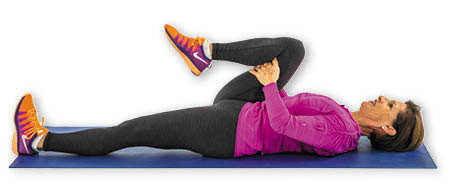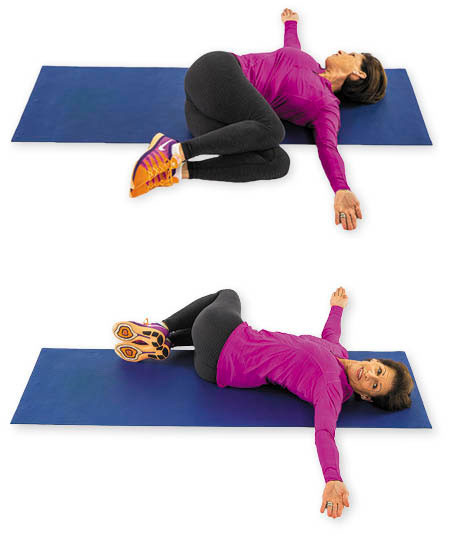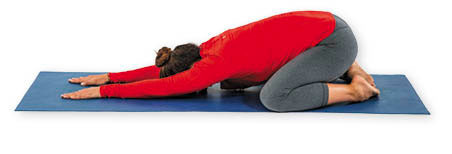Relieve low back pain with stretching
Stretching promotes harmony among muscles so they can support the back properly and ward off pain.
- Reviewed by Anthony L. Komaroff, MD, Editor in Chief, Harvard Health Letter; Editorial Advisory Board Member, Harvard Health Publishing

Life takes a toll on the lower back. All the standing, bending, lifting, and twisting are sometimes too much for the spine — something you find out when lower back pain strikes. Soothing the pain can require a combination of treatments. Muscle stretching is an important approach to add to the list.
Muscles, the back's unsung heroes
Your spine is a stack of interlocking bones (vertebrae) with cushions (discs) in between, and joints (facet joints) connecting each vertebra to the next. The facet joints allow your spine to bend and twist.
This great architecture relies on muscles to support it and to help you move. The muscles that do most of the work are the erector spinae muscles along the spine, the iliopsoas muscles connecting the spine to the lower limbs, and the abdominal muscles in the front of the body that help prop up the torso.
Other muscles that support the back include the hip flexors in the front of the hips, the hamstrings in the back of the thighs, and the gluteus muscles in the buttocks.
When muscles get tight
If muscles get tight — perhaps from too much sitting — they get shorter. They're less flexible and don't work well together. This can trigger a cascade of effects that cause low back pain.
"Tight back muscles inhibit the facet joints from moving the way they're supposed to, which can be painful. Tight muscles can also pull on other structures in the body. For example, if the hamstrings are tight, they pull the pelvis down. The pelvis connects to the low back. And if the pelvis is being pulled, the low back is being pulled, which can hurt," says Christina Ruggeri, a physical therapist in the sports medicine division of Harvard-affiliated Spaulding Rehabilitation Hospital.
Another example: Tight muscles in the buttocks can pinch the nearby sciatic nerve, triggering pain in the low back and all the way down the leg.
Stretches for chronic low back pain
To promote harmony among muscles, bones, and joints, you need to stretch the muscles. If you have recurring (chronic) low back pain, you can do this when the pain strikes.
Ruggeri says one helpful stretch involves lying on your back and pulling your legs close to your chest for half a minute. You can do this on a bed or on the floor. We've provided other stretches. These stretches work several muscle groups at the same time, such as muscles in the low back, buttocks, and front of the hips.
"Just be gentle when you stretch, so you help your muscles and don't injure them or aggravate the cause of the pain, such as a compressed nerve," Ruggeri says.
Don't stretch with new pain
If you experience back pain that's sudden and new, it could be from an injury, such as a muscle strain. In that case, go easy on your back for a few days. If the pain doesn't go away, call your doctor to report your symptoms.
Some symptoms that accompany new, intense low back pain should prompt an immediate call to your doctor: fever, sudden or worsening leg weakness, problems controlling urination or bowel movements, or numbness in your groin or anal area. These symptoms can indicate infection or another serious back problem.
Make it a habit
Stretching to quell chronic low back pain is most effective when you do it regularly, since it helps prevent recurrences. You can stretch a few times a week or every day.
For a full-body stretch, warm up the muscles in advance by marching in place for a few minutes while moving your arms around. This gets blood flowing to the muscles so they're pliable. Then, stretch all the major muscle groups, including your shoulders, back, abdomen, buttocks, and legs.
Just make sure you start a stretching regimen slowly. "Don't hold a stretch longer than 30 seconds, and don't bounce," Ruggeri says. "Every few days, increase the length of the stretch until you can hold it for a minute."
Stop stretching if your pain gets worse during a stretch. And don't start stretching on your own if you have a diagnosed back problem such as severe spinal stenosis (narrowing of the spinal canal), leaking or worn-out discs, or severe lower back arthritis. In that case, a physical therapist will need to assess your ability and tailor a stretching program for your needs.
In addition to stretching your muscles, you'll need to strengthen them regularly to keep them healthy, and do aerobic exercise — the kind that gets your heart and lungs working, like brisk walking — for about 150 minutes a week. For more information on solutions to help relieve an aching back, check out the Harvard Special Health Report Back Pain (/backpain).
Single knee pull

Lie on your back on a bed or the floor. Bend your right knee. Grasp the back of your thigh and pull your knee in toward your chest. Flex your left foot and press the thigh and calf of that leg down toward the floor to feel a stretch in the front of your left hip and top of your left thigh. Hold 10 to 30 seconds, return to the starting position, and repeat with the other leg. Repeat the process three times.
Double knee torso rotation

Lie on your back on a bed or the floor, with your knees bent and feet together. Put your arms out to each side at shoulder level, palms up. Tighten your abdominal muscles, lift both knees toward your chest, then lower them together to the left side on the floor. Keep your shoulders relaxed and pressed into the floor. Look in the opposite direction, and feel the stretch across your chest, torso, lower back. and hip. Hold 10 to 30 seconds. Bring both knees back to center, then repeat the stretch on your right side. Repeat the exercise three times.
Child's pose

Get on all fours, knees hip-width apart, with your big toes touching. Slowly drop your buttocks back toward your heels as you extend your hands in front of you and rest your forehead on the mat. Feel the stretch down your arms, shoulders, and back. Hold for 10 to 30 seconds. Return to the starting position and repeat the process three times.
Top image: © courtneyk/Getty Images; exercise photos by Michael Carroll
About the Author

Heidi Godman, Executive Editor, Harvard Health Letter
About the Reviewer

Anthony L. Komaroff, MD, Editor in Chief, Harvard Health Letter; Editorial Advisory Board Member, Harvard Health Publishing
Disclaimer:
As a service to our readers, Harvard Health Publishing provides access to our library of archived content. Please note the date of last review or update on all articles.
No content on this site, regardless of date, should ever be used as a substitute for direct medical advice from your doctor or other qualified clinician.
















